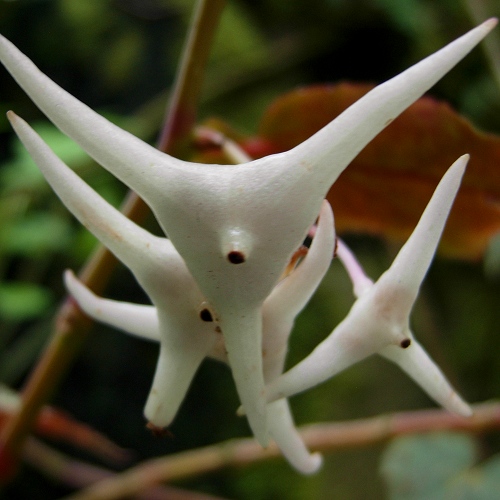Germinating the seeds
If you have germinated other Begonias before (not tropical, terrarium Begonias), you may use the same technique that worked for you. The tips below reflect what has worked for me, although other methods can certainly work. Getting started -- Plant your seeds when you receive them for best results. Use about 6 to 10 small pots or cups that are 2-4 inches (5-10 cm) tall. The pots should have drainage holes. Use well-draining soil. I use a mix of 1 part
coir fiber The seeds are tiny, so work in a well-lit area. Fill the pots with soil and sprinkle several seeds evenly across the surface of each pot. An easy way to pick up the seeds is by breathing on your finger tip to lightly moisten it, then dabbing the seeds with it. If you have
long-fibered sphagnum moss Add water until the soil is evenly moist, but not soggy. Until the seeds sprout, ensure that the soil surface never dries out. An easy way to maintain high humidity by enclosing the pots in a plastic container or bag - just leave it open slightly to let in fresh air. Once or twice a day, drip a few drops of water on the surface to keep it moist. The seeds germinate well at about 65-77 degrees F (18-25°C). I don't have experience germinating them outside this temperature
range. I recommend placing a
minimum/maximum thermometer Place the containers in a bright spot out of direct sun. An LED or fluorescent bulb kept 4 inches (10 cm) away provides the right amount of light (See: "Growing indoors with LED lights"). The seeds should start sprouting in 2-4 weeks, but may take longer at cooler temperatures. Continue dripping water on the soil surface after they sprout, since young seedlings have a small root system. Increase the air ventilation slightly after the sprout to prevent rot. When the seedlings are 1-2 months old, you may carefully pull them and transplant them, or you can cut off any slower ones, leaving 1 strong seedling in each pot. Fertilizing -- Feed weekly with a small amount of dilute (1/8 strength) liquid fertilizer. Hydroponic fertilizer is ideal for this, because it is easily absorbed and contains all essential nutrients. After 3 months, you may switch to a granular fertilizer that contains micronutrients, following the directions on the package. Or continue feeding weekly with liquid fertilizer at 1/8 strength. Watering -- Once the seedlings are a month old, you may stop keeping the soil surface moist at all times. Aim to keep the rest of the soil evenly moist (but not soggy). Lighting -- The plant likes filtered sun or bright shade + morning sun. Protect it from strong afternoon sun. Transplanting -- When the seedlings are 2 months old, repot to a larger container about 1 quart (1 liter) in size. Water the soil before repotting, to keep the soil ball from breaking apart, which can damage the roots. Protect from direct sun the first week after repotting. Climate -- It seems to prefer conditions favored by intermediate-temperature Orchids, which is to say about 65 to 75 degrees F (18-24 C) during the day, and 60 to 70 F (16-21 C) at night. I have no experience with it in hotter conditions, but it's possible that high heat might stress it, especially if nights are warm. It tolerates cool conditions, but i don't think it can survive frost. It grows well indoors in higher humidity (above 50%). I have not tried growing it at lower humidity. If it seems to suffer from low humidity, consider using an ultrasonic humidifier, sold at home improvement stores and some thrift shops. Another option is growing it in a terrarium, although i haven't tried this. If you have any questions or problems, please contact me. Have fun growing them! - Jeff Strange Wonderful Things
|
|||||||||


